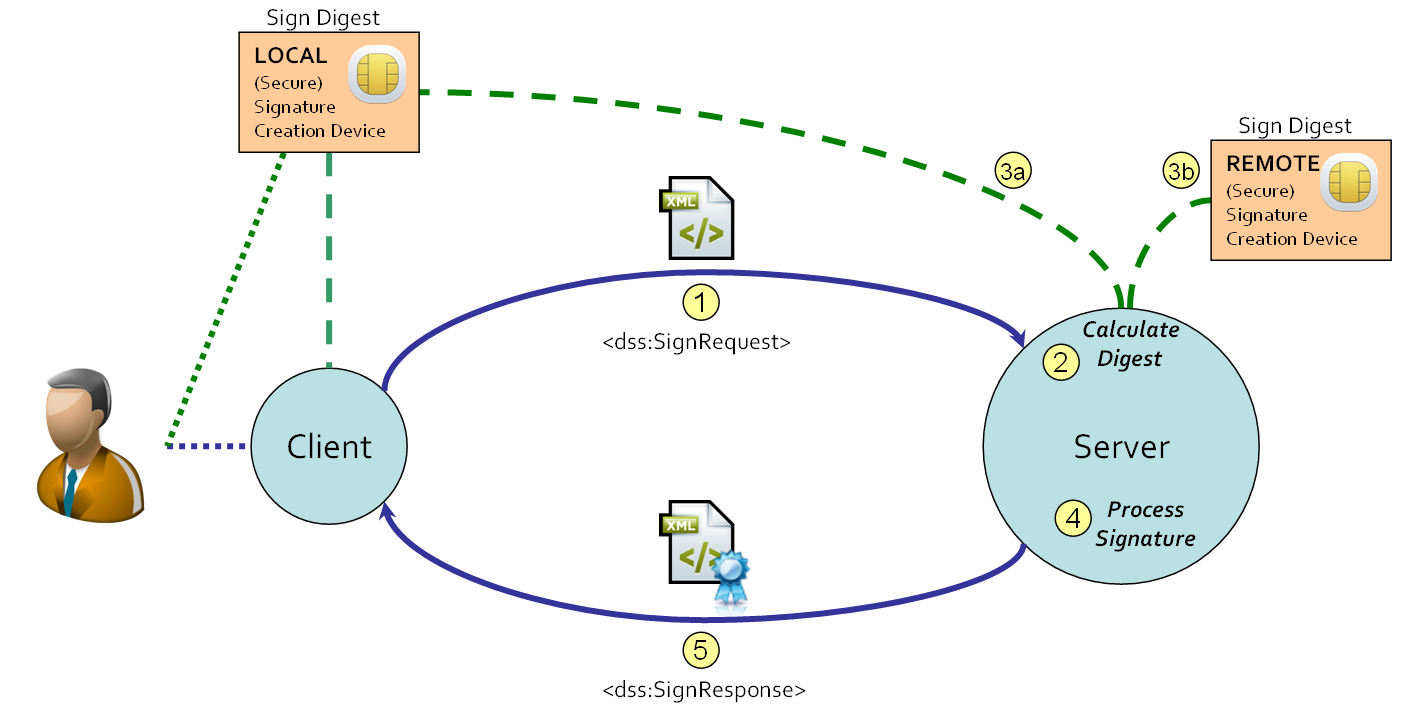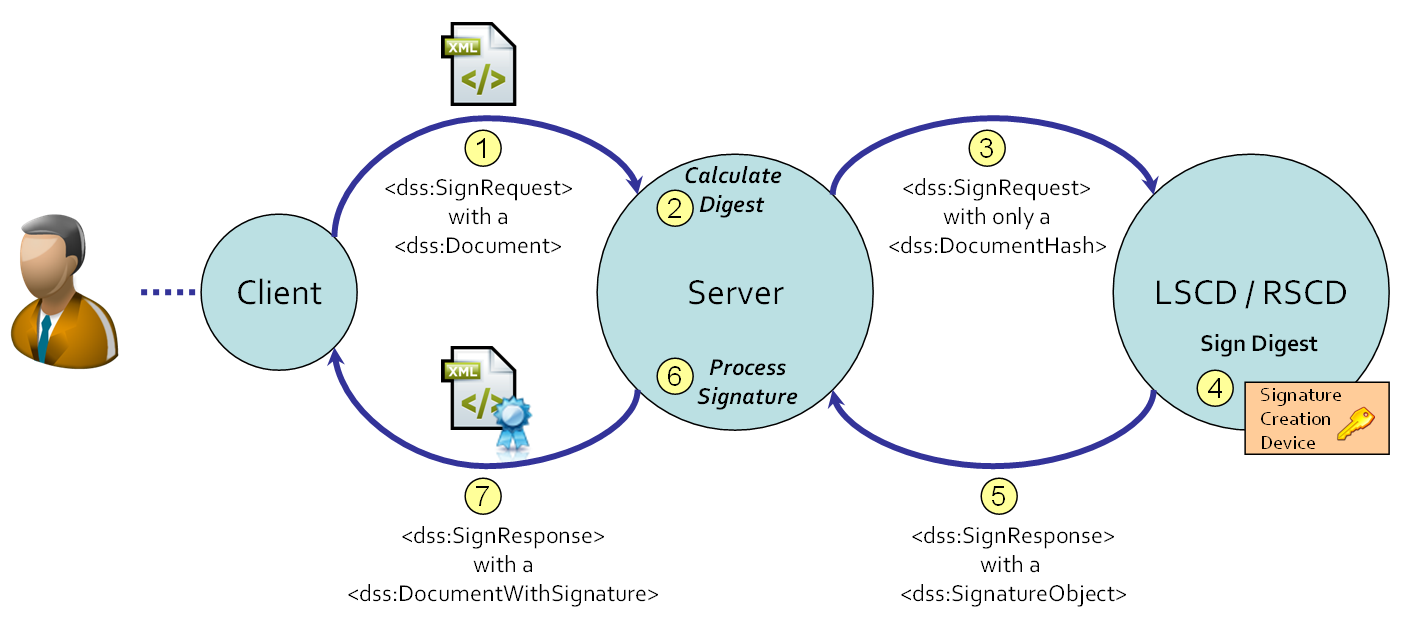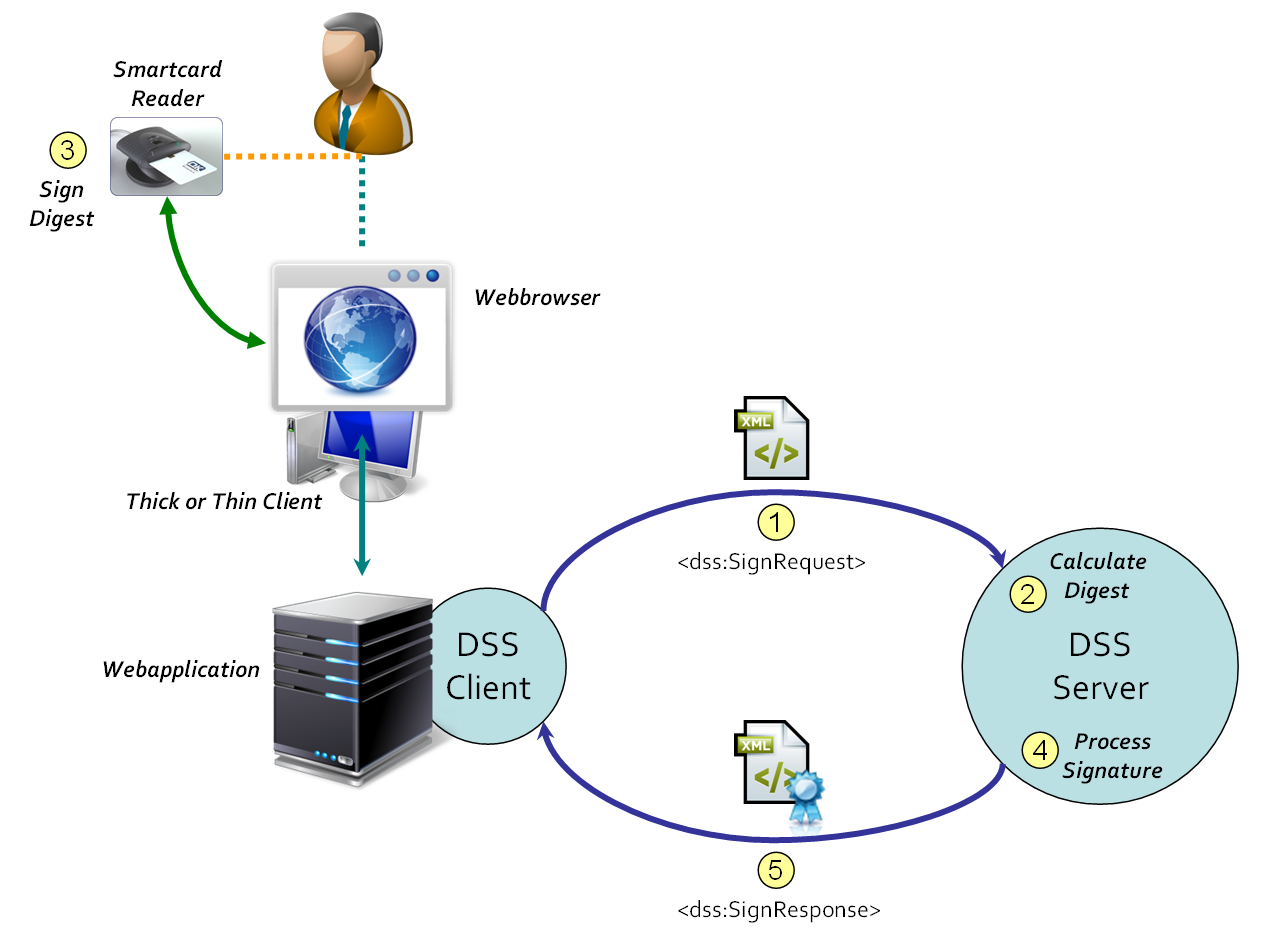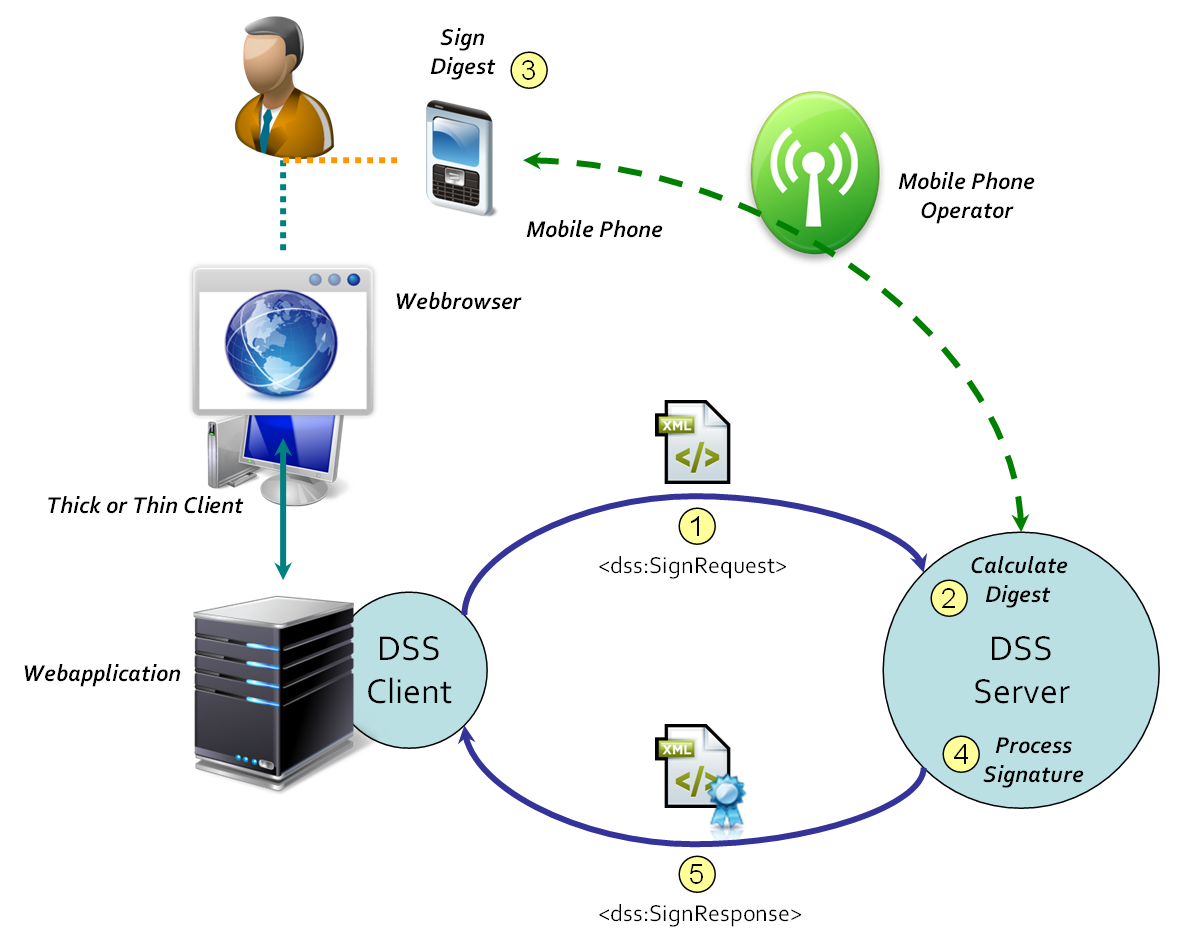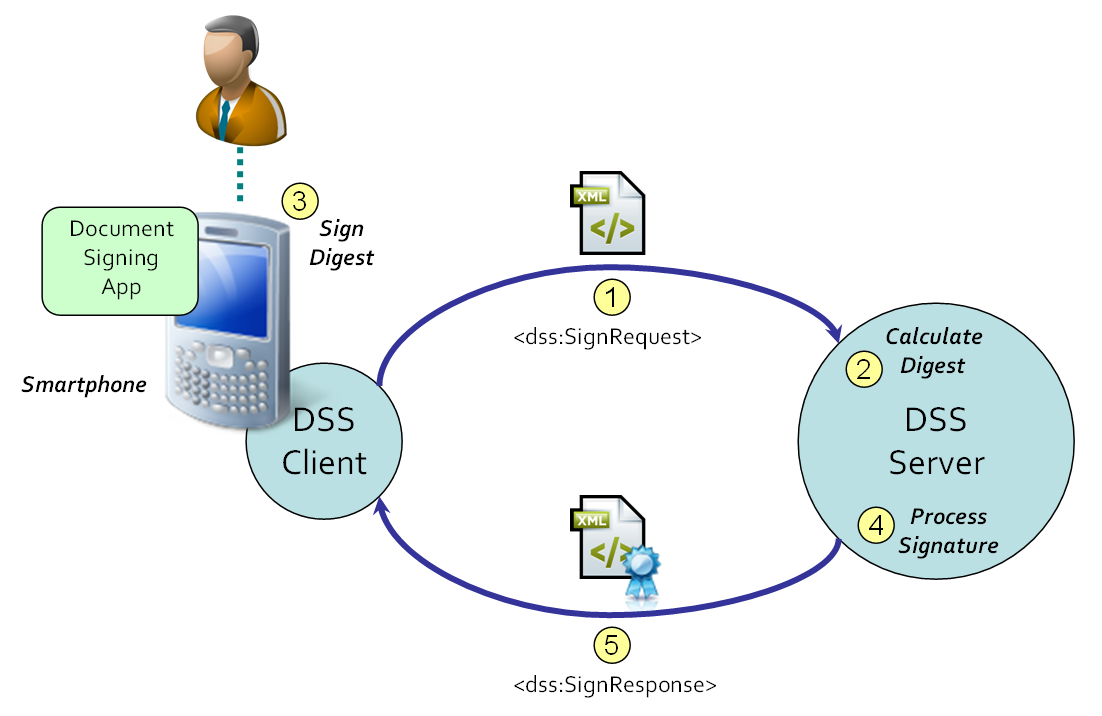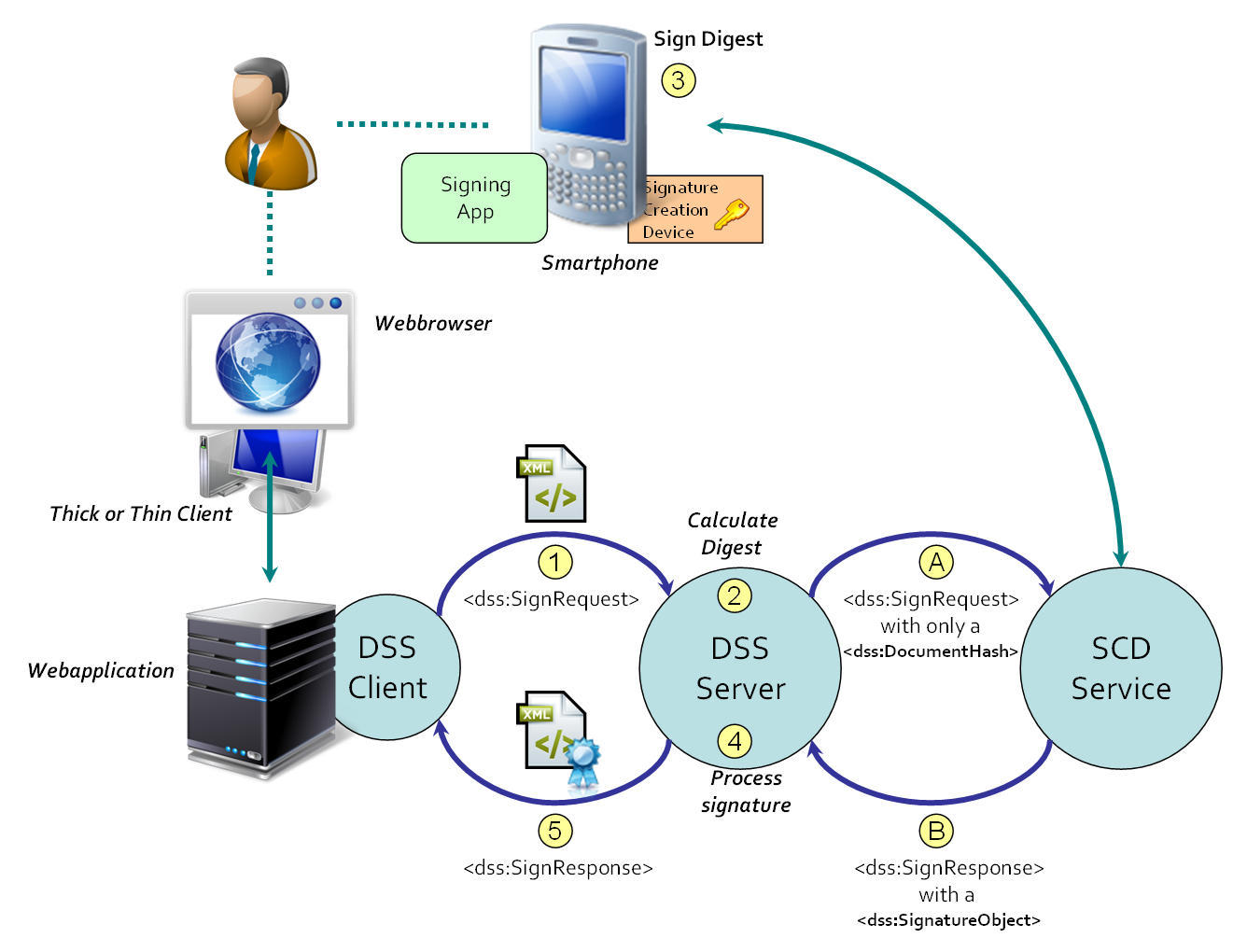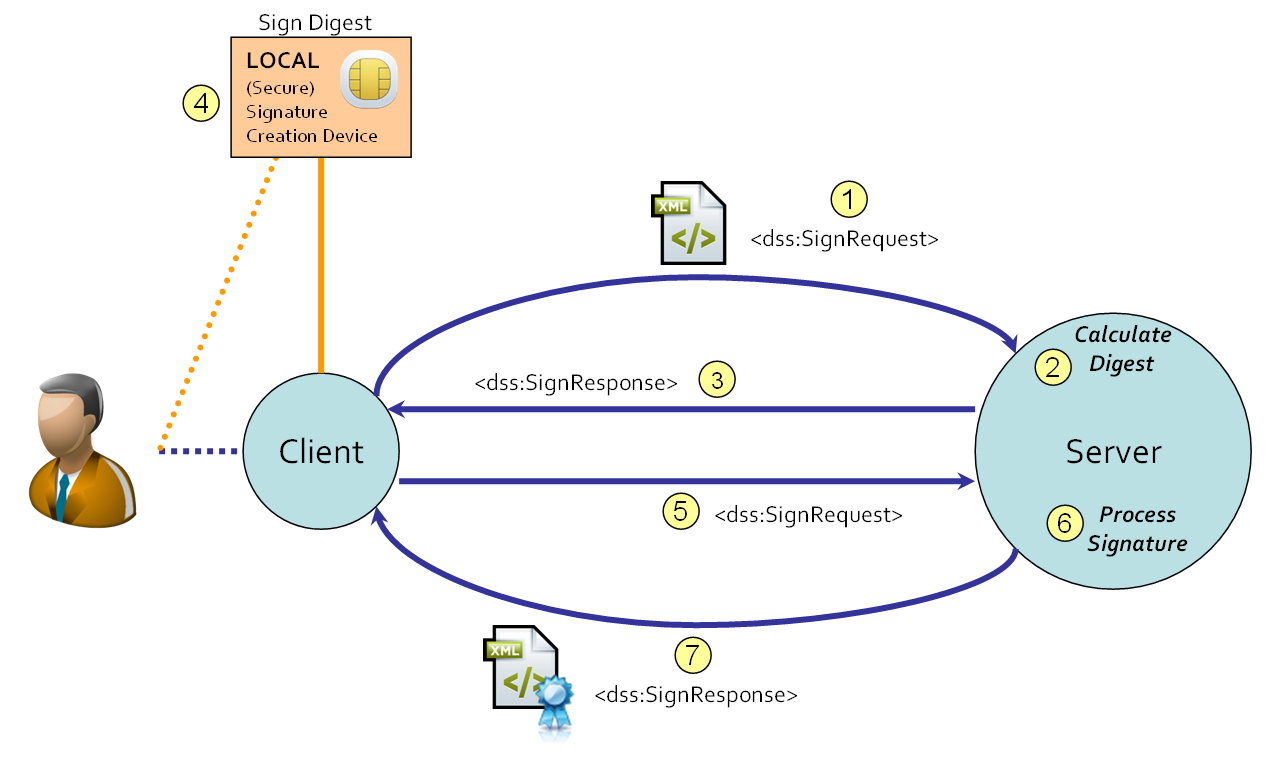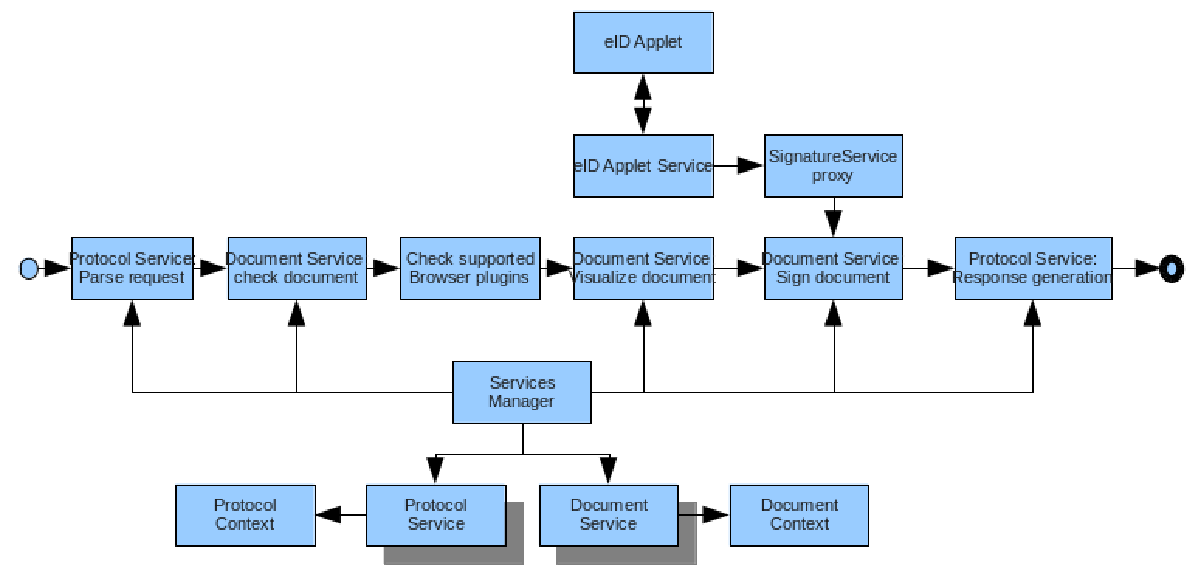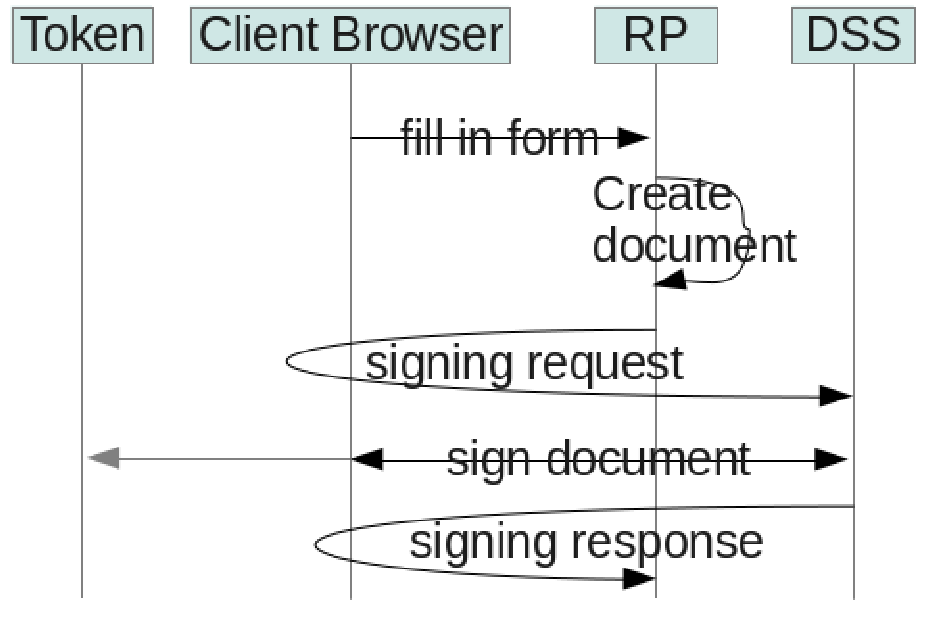Committee Specification 01 /
Public Review Draft 01
16 January 2014
- Specification URIs
- This version:
- http://docs.oasis-open.org/dss-x/localsig/v1.0/csprd01/localsig-v1.0-csprd01.html
(Authoritative)
http://docs.oasis-open.org/dss-x/localsig/v1.0/csprd01/localsig-v1.0-csprd01.pdf
http://docs.oasis-open.org/dss-x/localsig/v1.0/csprd01/localsig-v1.0-csprd01.xml
- Previous version:
- N/A
- Technical Committee:
- OASIS Digital Signature Services eXtended (DSS-X) TC
- Chairs:
- Juan Carlos Cruellas (cruellas@ac.upc.edu), UPC-DAC
Stefan Drees (stefan@drees.name), Individual
- Editors:
- Ernst Jan van Nigtevecht (ejvn@sonnenglanz.net), Sonnenglanz Consulting BV
Frank Cornelis (frank.cornelis@fedict.be), FedICT
- Related work:
This specification is related to:
Digital Signature Service Core Protocols, Elements, and Bindings Version 1.0. 11 April 2007. OASIS Standard. http://docs.oasis-open.org/dss/v1.0/oasis-dss-core-spec-v1.0-os.html.
- Abstract:
The core OASIS Digital Signature Service webservice [DSSCore] supports the creation of signatures on behalf of applications and / or users by utilizing server-based signature keys.
This Local Signature Computation profile extends the core functionality such that end users can bring (use) their own (secure) signature-creation device. Examples of such devices are smartcards or usb-tokens but also smartphones, mobile phones, tablets, pc's or laptops with privately held signature keys.
Three solutions are presented to support the varying capabilities of applications and different use cases. The first solution is useful for web-applications where web browsers can access the (secure) signature-creation device that is available at the desktop (e.g. a smartcard connected via USB). The second solution is useful for applications that can access the (secure) signature-creation device themselve, for instance desktop applications or smartphone apps. The third solution is useful for any application where the (secure) signature-creation device can only be accessed via a separate channel, for instance a mobile device, through a third-party.
- Status:
This document was last revised or approved by the OASIS Digital Signature Services eXtended (DSS-X) TC on the above date. The level of approval is also listed above. Check the "Latest version" location noted above for possible later revisions of this document.
Technical Committee members should send comments on this specification to the Technical Committee's email list. Others should send comments to the Technical Committee by using the "Send A Comment" button on the Technical Committee's web page at http://www.oasis-open.org/committees/dss-x/.
For information on whether any patents have been disclosed that may be essential to implementing this specification, and any offers of patent licensing terms, please refer to the Intellectual Property Rights section of the Technical Committee web page (http://www.oasis-open.org/committees/dss-x/ipr.php).
- Citation format:
When referencing this specification the following citation format should be used:
[localsig-v1.0] DSS Extension for Local Signature Computation Version 1.0. Edited by Ernst Jan van Nigtevecht and Frank Cornelis. 16 January 2014. OASIS Committee Specification Draft 01 / Public Review Draft 01. http://docs.oasis-open.org/dss-x/localsig/v1.0/csprd01/localsig-v1.0-csprd01.html. Latest version: http://docs.oasis-open.org/dss-x/localsig/v1.0/localsig-v1.0.html.
Notices
Copyright © OASIS Open 2014. All Rights Reserved.
All capitalized terms in the following text have the meanings assigned to them in the OASIS Intellectual Property Rights Policy (the "OASIS IPR Policy"). The full Policy may be found at http://www.oasis-open.org/who/intellectualproperty.php.
This document and translations of it may be copied and furnished to others, and derivative works that comment on or otherwise explain it or assist in its implementation may be prepared, copied, published, and distributed, in whole or in part, without restriction of any kind, provided that the above copyright notice and this section are included on all such copies and derivative works. However, this document itself may not be modified in any way, including by removing the copyright notice or references to OASIS, except as needed for the purpose of developing any document or deliverable produced by an OASIS Technical Committee (in which case the rules applicable to copyrights, as set forth in the OASIS IPR Policy, must be followed) or as required to translate it into languages other than English.
The limited permissions granted above are perpetual and will not be revoked by OASIS or its successors or assigns.
This document and the information contained herein is provided on an "AS IS" basis and OASIS DISCLAIMS ALL WARRANTIES, EXPRESS OR IMPLIED, INCLUDING BUT NOT LIMITED TO ANY WARRANTY THAT THE USE OF THE INFORMATION HEREIN WILL NOT INFRINGE ANY OWNERSHIP RIGHTS OR ANY IMPLIED WARRANTIES OF MERCHANTABILITY OR FITNESS FOR A PARTICULAR PURPOSE.
OASIS requests that any OASIS Party or any other party that believes it has patent claims that would necessarily be infringed by implementations of this OASIS Committee Specification or OASIS Standard, to notify OASIS TC Administrator and provide an indication of its willingness to grant patent licenses to such patent claims in a manner consistent with the IPR Mode of the OASIS Technical Committee that produced this specification.
OASIS invites any party to contact the OASIS TC Administrator if it is aware of a claim of ownership of any patent claims that would necessarily be infringed by implementations of this specification by a patent holder that is not willing to provide a license to such patent claims in a manner consistent with the IPR Mode of the OASIS Technical Committee that produced this specification. OASIS may include such claims on its website, but disclaims any obligation to do so.
OASIS takes no position regarding the validity or scope of any intellectual property or other rights that might be claimed to pertain to the implementation or use of the technology described in this document or the extent to which any license under such rights might or might not be available; neither does it represent that it has made any effort to identify any such rights. Information on OASIS' procedures with respect to rights in any document or deliverable produced by an OASIS Technical Committee can be found on the OASIS website. Copies of claims of rights made available for publication and any assurances of licenses to be made available, or the result of an attempt made to obtain a general license or permission for the use of such proprietary rights by implementers or users of this OASIS Committee Specification or OASIS Standard, can be obtained from the OASIS TC Administrator. OASIS makes no representation that any information or list of intellectual property rights will at any time be complete, or that any claims in such list are, in fact, Essential Claims.
The name "OASIS" is a trademark of OASIS, the owner and developer of this specification, and should be used only to refer to the organization and its official outputs. OASIS welcomes reference to, and implementation and use of, specifications, while reserving the right to enforce its marks against misleading uses. Please see http://www.oasis-open.org/who/trademark.php for above guidance.
Table of Contents
Appendixes
The OASIS Digital Signature Services specification [DSSCore] standardizes a protocol by which (i) a client can send documents (or document digests) to a server and receive back a signature on the documents, or by which (ii) a client can send documents (or document digests) and a signature to a server, and receive back an answer on whether the signature verifies the documents.
These operations could be useful in a variety of contexts, for example they could allow clients to access a single corporate key for signing press releases, with centralized access control, auditing, and archiving of signature requests. They could also allow clients to create signatures without needing complex client software and configuration.
This profile extends the OASIS DSS protocol such that a (secure) signature-creation device (an SSCD or SCD), under the direct control of the user, is used for the actual computation of the digital signature value. The (secure) signature-creation device is not part of, nor located at, the server that implements the DSS protocol.
The (secure) signature-creation device may have limited software and performance capabilities and hence may be supported by a OASIS DSS compliant service to handle the complexities of the (secure) signature-creation and document manipulation.
The key words MUST, MUST NOT, REQUIRED, SHALL, SHALL NOT, SHOULD, SHOULD NOT, RECOMMENDED, MAY, and OPTIONAL are to be interpreted as described in [RFC 2119].
These keywords are capitalized when used to unambiguously specify requirements over protocol features and behavior that affect the interoperability and security of implementations. When these words are not capitalized, they are meant in their natural-language sense.
This specification uses the following typographical conventions in text:
<ns:Element>, Attribute,
Datatype, OtherCode.
An input document that has to be signed can be any piece of data that can be used as input to a signature calculation, according to the [DSSCore] specification. Such a document can even be a signature (for example, a pre-existing signature can be counter-signed) or timestamp.
A digital signature value is a basic form of a signature, usually in the form of a PKCS#1 format ([PKCS#1 version 2.1] or [PKCS#1 version 2.2]). The digital signature value is computed by the (secure) signature-creation device for a given digest. The validity of the corresponding certificate is not checked by the device.
An electronic signature is an enriched digital signature value and can include for instance a time-stamp (to specify the time of signing) and/or revocation information (to specify the validity of the corresponding certificate and trusted roots and/or intermediate certificates). Additionally, the electronic signature will only be created by the Digital Signature Service if the corresponding certificate is valid (not revoked).
SCD: Signature-Creation Device. A device that is capable of creating a digital signature value using a private key that is stored in the device.
SSCD: Secure Signature-Creation Device. A signature-creation device which meets the requirements laid down in Annex III of the European Directive 1999/93/EC of the European Parliament and the Council of 13 December 1999 on a Community framework for electronic signatures [1999/93/EC].
LSCD: Local Signature-Creation Device. A (secure) signature-creation device that is owned by and in the proximity of an end user.
RSCD: Remote Signature-Creation Device. A (secure) signature-creation device that is owned by, but not in the proximity of, an end user. Nonetheless, the usage of the device is (by some other means) under the control of the end user.
Client: A requester of a particular resource or service that is provided by a server.
Server: A provider of a resource or service that is used by a client.
[DSSCore] S. Drees et al., Digital Signature Service Core Protocols and Elements, OASIS, April 2007, http://docs.oasis-open.org/dss/v1.0/oasis-dss-core-spec-v1.0-os.pdf
[Excl-C14N] J. Boyer et al., Exclusive XML Canonicalization Version 1.0, World Wide Web Consortium, July 2002, http://www.w3.org/TR/xml-exc-c14n/
[HTML401] D. Raggett et al., HTML 4.01 Specification, World Wide Web Consortium, December 1999, http://www.w3.org/TR/html4
[RFC 2119] S. Bradner, Key words for use in RFCs to Indicate Requirement Levels, http://www.ietf.org/rfc/rfc2119.txt IETF (Internet Engineering Task Force) RFC 2119, March 1997.
[RFC 2616] R. Fielding et al., Hypertext Transfer Protocol - HTTP/1.1, http://www.ietf.org/rfc/rfc2616.txt IETF (Internet Engineering Task Force) RFC 2616, June 1999.
[RFC 3061] M. Mealling, A URN Namespace of Object Identifiers, http://tools.ietf.org/rfc/rfc3061.txt IETF (Internet Engineering Task Force), February 2001.
[SAMLCore] S. Cantor et al., Assertions and Protocols for the OASIS Security Assertion Markup Language (SAML) V2.0, OASIS, March 2005, http://docs.oasis-open.org/security/saml/v2.0/saml-core-2.0-os.pdf
[XHTML] XHTML 1.0 The Extensible HyperText Markup Language (Second Edition), World Wide Web Consortium Recommendation, August 2002, http://www.w3.org/TR/xhtml1/
[XMLSig] D. Eastlake et al., XML-Signature Syntax and Processing, W3C Recommendation, June 2008, http://www.w3.org/TR/xmldsig-core/
[XML-ns] T. Bray, D. Hollander, A. Layman, Namespaces in XML, W3C Recommendation, January 1999, http://www.w3.org/TR/1999/REC-xml-names-19990114
[XML-Schema] H. S. Thompson et al., XML Schema Part 1: Structures, W3C Recommendation, May 2001, http://www.w3.org/TR/xmlschema-1/
[ECC] CEN CEN-TS 15480 / CEN/TC 224 - Personal identification, electronic signature and cards and their related systems and operations
[M-COMM] ETSI Mobile Commerce (M-COMM); Mobile Signatures; Business and Functional Requirements, ETSI Technical Report 102 203 V1.1.1, May 2003
[1999/93/EC] Directive 1999/93/EC of the European Parliament and the Council of 13 December 1999 on a Community framework for electronic signatures. http://eur-lex.europa.eu/LexUriServ/LexUriServ.do?uri=CELEX:31999L0093:en:HTML
[PKCS#1 version 2.1] Public-Key Cryptography Standards (PKCS) #1: RSA Cryptography Specifications Version 2.1, IETF RFC 3447, February 2003. http://tools.ietf.org/html/rfc3447
[PKCS#1 version 2.2] PKCS#1 v2.2: RSA Cryptography Standard, RSA Laboratories, October 27, 2012. http://www.rsa.com/rsalabs/pkcs/files/h11300-wp-pkcs-1v2-2-rsa-cryptography-standard.pdf
[draft-larmouth-oid-iri-04] J. Larmouth, An IRI/URI Namespace for International Object Identifiers (OIDs), http://tools.ietf.org/id/draft-larmouth-oid-iri-04.txt IETF (Internet Engineering Task Force) DRAFT, July 24, 2005.
The structures described in this specification are contained in the schema file which is part of Section A.1, “Schema”. All schema listings in the current document are excerpts from the schema file. This schema is associated with the following XML namespace:
http://docs.oasis-open.org/dss-x/ns/localsigConventional XML namespace prefixes are used in this document:
The prefix
xs:stands for the W3C XML Schema namespace [XML-Schema].The prefix
ds:stands for the W3C XML Signature namespace [XMLSig].The prefix
dss:stands for the OASIS DSS core namespace [DSSCore].The prefix
localsig:stands for the OASIS DSS-X local signature profile namespace.
Applications MAY use different namespaces, and MAY use whatever namespace defaulting/scoping conventions they desire, as long as they are compliant with the Namespace in XML specification [XML-ns].
OASIS Digital Signature Service (DSS) protocol such that an electronic signature can be created by means of a (secure) signature-creation device under the direct control of an end user. This section lists the requirements for the local signature computation profile.
It shall be possible to use a (secure) signature-creation device (using protocols such as [ISO/IEC 7816], [ISO/IEC 24727] and [CEN 15480]) at a different location from the OASIS DSS server.
It shall be possible to specify a digest method (algorithm) to be used in the (secure) signature-creation process.
It shall be possible to obtain the digest for a given input documents (and document type) and given digest method (algorithm).
The DSS protocol assumes a client-server relationship. The client initiates a SignRequest (1) and the server creates the electronic signature for the input document (2, 3 and 4). The resulting electronic signature (and whenever requested the document) is sent back to the client in the SignResponse (5). This is shown in the figure below.
Note that the signature-creation device (SCD) is (by default) part of the server that implements the OASIS DSS protocol.
Such an architecture is applicable in case the end users do not own a signature-creation device (SCD). However, large-scale signing token deployments increase the use of (secure) signature-creation devices that are owned by and in the proximity of an end user. Examples are:
National eID cards or European Citizen Card [ECC], containing a secure signature-creation device ([1999/93/EC]).
Mobile devices, where the SIM card can be used as a secure signature-creation device (SSCD) [M-COMM].
In such scenarios it is still interesting to keep a OASIS DSS in place for several reasons:
Despite the fact that every person owns a token with signing capability, he/she might not have the appropriate software installed on the system for the creation of electronic signatures. It might be easier to maintain a lightweight solution, for instance by means of an applet, instead of a full blown token middleware that has to be installed on every participating client's system. The diversity among the client platforms is also easier to manage from a centralized service instead of distributing token middleware to all participating client systems. Furthermore, managing the configuration of the signature policy to be used for the creation of electronic signatures within a certain context might be easier using a centralized service.
Transforming a business workflow that is based on paper-documents into a digital equivalent, requires a sub-process for the creation (and validation) of electronic signatures on digital documents. Such a sub-process should be available as a service that can be easily integrated with a business application.
From a technical point of view it might be easier to maintain different OASIS Digital Signature Services, each specialized in handling a specific signature and token types. E.g. tokens per vendor, or per country.
This profile extends the OASIS DSS protocol such that end users can present their own (secure) signature-creation device. Consequently, the device itself is not located at the server that implements the DSS protocol.
Although the (secure) signature-creation device is under the control of the end user, the location of the device can be local or remote. The following terminology is used:
if the (secure) signature-creation device is in the proximity of the end user, it is referred to as a LOCAL (secure) signature-creation device, abbreviated to LSCD;
if the (secure) signature-creation device is owned by the end user and stored at a remote site (still under the direct control of the end user, but not in the proximity of the end user), it is referred to as a REMOTE (secure) signature-creation device, abbreviated to RSCD.
Note that from the viewpoint of the Digital Signature Service, both LSCD and RSCD have to be treated as remote devices.
The following diagram visualizes the (logical) relationship between the LSCD (or RSCD) and the Digital Signature Service.
To re-use the existing DSS core protocol functionality as much as possible, the Digital Signature Service could delegate the computation of the digital signature value as depicted below. It assumes that the LSCD or RSCD implements a basic DSS protocol to serve the sign requests of a digest; only the basic signature operations are assumed (no on-line certificate validation, timestamp requests, etcetera).
In general, the LSCD or RSCD may have limited software and performance capabilities and hence may be supported by a OASIS DSS compliant service to handle the complexities of the (secure) signature-creation, electronic signature processing and document manipulation. Furthermore, in general, the LSCD or RSCD might not be accessible through a DSS core protocol.
The LSCD or RSCD must at least be able to serve a request to sign a given digest. It is assumed that the interface to the actual (S)SCD is accessed through one of the possible standards, such as the APDU (ISO 7816) or the IFD-Client (ISO/IEC 24727 / CEN 15480) standard. It shows that the profile should not depend on the actual interface of the (S)SCD. It is assumed that there will be some middleware that abstracts from the vendor-specific implementation of the (S)SCD.
The introduction of an LSCD or RSCD can have different use cases, depending on the technology as well. For instance, is the LSCD integrated in a mobile device and is the DSS client running on different platform? Or is the LSCD connected to the DSS client? The next section present a number of use cases that are considered for this profile.
The basic sequence within the use cases is as follows. A user initiates a signing action by means of a client application. The client application initiates a SignRequest to the Digital Signature Service (1). The Digital Signature Service calculates the digest (2), obtains a digital signature value by some mechanism (3), creates the electronic signature from the digital signature value and processes it according to the request (4). The resulting electronic signature (and whenever requested the document) is sent back to the client in the SignResponse (5).
This use case assumes a thick or thin client platform. The (secure) signature-creation device can be a smartcard connected to the client platform by means of a smartcard reader. A web browser is used to let the end user access the web application. The web application has implemented the DSS protocol. To sign (a) document(s), the web application sends the document(s) to the DSS server; the DSS server must obtain (somehow) the digital signature value computed by the smartcard. Note that the DSS server cannot access the smartcard reader without additional mechanisms; proposals to solve this are presented in section Section 1.7.3, “Proposed Solutions”.
This use case assumes the use of a mobile phone that contains a (secure) signature-creation device. The mobile phone is connected to the mobile operator infrastructure. A web browser is used to let the end user access the client application. The client application has implemented the DSS protocol. To sign (a) document(s), the client sends the document(s) to the DSS server; the DSS server must obtain the digital signature value computed by the smartcard in the mobile phone. The DSS server connects to the mobile phone which requests the user to sign (the provided digest).
This use case resembles the ETSI standard for Mobile Commerce (M-COMM) or Mobile Signature Service [M-COMM].
This use case assumes the use of a smartphone that contains a (secure) signature-creation device. The smartphone contains an app to sign (a) document(s), although the actual electronic signature processing functionality is delegated to a DSS server. The app has implemented the DSS protocol and the use of the (secure) signature-creation device in the smartphone. Note that the DSS server cannot access the (secure) signature-creation device without additional mechanisms; proposals to solve this are presented in section Section 1.7.3, “Proposed Solutions”.
This use case is a generalisation of use case 2. It assumes the use of a mobile device that may contain a (secure) signature-creation device, in the proximity of the end user. If the mobile device does not contain a (secure) signature-creation device it is assumed that it is located at the "SCD Service". The mobile device can have more capabilities than a mobile phone. For instance, a smartphone with an internet connection and an app to interact with the "SCD Service".
To sign (a) document(s), the client sends the document(s) to the DSS server. The DSS server delegates the actual computation of the digital signature value to another service: the digest is sent to the "SCD Service", with possibly (but not necessarily) a <dss:SignRequest> (A). The "SCD Service" is able to deliver a digital signature value, based on the interaction with the mobile device by means of a certain protocol.
If the smartphone contains a (secure) signature-creation device, it receives or retrieves the digest from the "SCD Service" and computes the digital signature value for the digest (3), after which the digital signature value is returned to the "SCD Service". The "SCD Service" responds with possibly (but not necessarily) a <dss:SignResponse> (B) to the DSS server.
Note that some secure correlation is required between the initial user request and the interaction with the smartphone.
This use case can make use of the ETSI standard for Mobile Commerce (M-COMM) or Mobile Signature Service [M-COMM]
This section describes three possible technical solutions for different use cases.
A User Agent at the client is introduced for use case 1 to access the (secure) signature-creation device (connected to the client platform) for the computation of the digital signature value.
A two-step approach is introduced for use case 1 and use case 3: the Digital Signature Service returns the document digest in the first step. After the client has computed the digital signature value for the document digest, it is returned to the Digital Signature Service in the second step (to enrich the digital signature value, for instance with a time-stamp and/or revocation information).
A third-party is introduced for use case 2 and use case 4: the Digital Signature Service delegates the computation of the digital signature value to a third-party. The third-party has some means to contact the (secure) signature-creation device of the end user.
To provide the Digital Signature Service access to a LSCD, a User Agent is introduced. The User Agent MUST provide access to the LSCD. The DSS client communicates with the DSS server via the User Agent; there is no direct communication between the DSS client and DSS server. The figure below illustrates how this is done.
The order of actions is as follows:
The DSS client sends the SignRequest to the User Agent.
The User Agent sends the SignRequest to the DSS server (1). The DSS server has obtained a session (connection) with the User Agent.
The DSS server calculates the digest (2) for the input document.
In order to have the digest signed, an interaction between the User Agent and the LSCD (3) is required. This interaction will be initated by the DSS server, by means of the session (connection) that has been obtained earlier. This profile does not specify how the User Agent obtains the digital signature value: it is left to the implementers.
Once the digital signature value has been obtained, the DSS server creates and processes (4) the electronic signature according the the request, and the SignResponse is built. (If requested, the electronic signature is embedded into the document.)
The DSS server sends the SignResponse to the User Agent (5)
The User Agent sends the SignResponse to the DSS client.
For achieving this User Agent approach a transport binding needs to be introduced:
A HTTP transport binding is defined for the use of a User Agent and HTML forms. The HTML form initiates a HTTP POST (from within the User Agent) to the specified action location (either the DSS server or the DSS client). This transport binding is referred to as a WEB FORM transport binding and can be found in Section 4.1, “WEB FORM Transport Binding”.
The OASIS DSS protocol could be split into two related request/response pairs, such that the client can obtain a digest of the document in the FIRST request/response. The client MUST be capable of accessing the LSCD. The client interacts with the LSCD to compute the digital signature value and sends it back to the DSS server by means of the SECOND request/response.
The order of actions is as follows:
The first step consists of a SignRequest (1) - SignResponse (3) pair where the SignResponse only contains the digest, calculated by the Digital Signature Service (2).
This digest is used by the client application to compute the digital signature value (4) by means of the (secure) signature-creation device at the client.
The second step consist of a SignRequest (5) - SignResponse (7) pair where the SignRequest contains the digital signature value. The Digital Signature Service builts and processes (6) the electronic signature based on the digital signature value and the request received. The result is sent to the client with the SignResponse (7).
Note that no assumptions are made about the actual connection or communication between the client and LSCD.
(Although the core DSS protocol could be used to send a <dss:DocumentHash> to the LSCD and to obtain a <SignatureObject>.)
The only assumption is that the client that implements the (client-side of the) DSS protocol is capable of using the LSCD.
For achieving this two-step approach some OptionalInputs and OptionalOutputs elements need to be introduced for the SignRequest or SignResponse:
An optional output
<ds:DocumentHash>element in the SignResponse. After the DSS server has received a SignRequest it calculates the digest of the document. The SignResponse contains the<dss:DocumentHash>value.An optional input
<dss:SignatureObject>element in the second SignRequest. After the DSS client has received the digest as a result of the first SignRequest, the LSCD computes the digital signature value and the client incorporates it to the aforementioned SignRequest using the<dss:SignatureObject>element. The DSS server will perform the necessary operations for building the final electronic signature, for incorporating it within the corresponding document if required, and for returning it within the corresponding SignResponse.An optional output (resp. input)
<localsig:CorrelationID>element in the first SignResponse (resp. second SignRequest). The correlation identifier is used to relate the first and second SignRequest/SignResponse pairs.
The Digital Signature Service delegates the computation of the digital signature value to a third-party for users with a mobile device that MAY contain a (secure) signature creation device (in that case, the mobile device contains the LSCD). If the mobile device does not contain a (secure) signature-creation device it is assumed that the third-party provides access to the RSCD on behalf of the end user by means of the mobile device. See for instance Section 1.7.2.2, “Use Case 2” and Section 1.7.2.4, “Use Case 4” .
Because the end user must be assured that it signs the correct request, an additional mechanism is introduced: a challenge code. The challenge code is a kind of 'one-time-password': it is different for every session. The challenge code will be shown at the client screen as well as the screen of the mobile device (the DSS server sends the challenge code to the third-party). The end user compares the codes and if they are the same confirms the sign request.
Note. The challenge code could even be used for a kind of challenge-response authentication by the Digital Signature Service. If the SignRequest also contains a response code, it is expected that the end user enters that code at the mobile device. The electronic signature is only created and processed (by the Digital Signature Service) if the response codes match. Note that the challenge-response does not protect the end user from misuse of the signature by the third-party. (But the signature is bound to the document by means of a unique hash value, making it useless for other documents.)
The DSS client MUST be able to create the challenge (and optionally a response) code, unique for every session, and MUST display the code(s) onto the screen of the client.
The order of actions is as follows:
The client sends a SignRequest, which also contains a challenge code, to the Digital Signature Service (1).
The Digital Signature Service calculates the digest of the document (2) and delegates the computation of the digital signature value to a third-party (3), for instance a Mobile Signature Service.
The third-party sends the request to the mobile device of the end user. The end user has to compare the challenge code with the code that is shown on the mobile device (as part of the information that is sent from the third-party to the mobile device). Once the end user has confirmed the code, the mobile device computes the digital signature value (4) and sends it back to the third-party. The third-party returns the digital signature value to the Digital Signature Service.
The Digital Signature Service creates and processes the electronic signature (5) based on the digital signature value and the request received. The resulting electronic signature is returned to the client in the SignResponse (6).
The protocol between the Digital Signature Service and third-party is not specified by this profile, but the DSS protocol can be used for this as well, see for instance Figure 3, “Delegation of the signature creation to the LSCD or RSCD”. (It is assumed that the challenge code is included in the request to the third-party.)
Note that information is required about the identity of the end user to enable the third-party to communicate with the appropriate mobile device.
It is assumed that the element <dss:ClaimedIdentity> is sufficient for this purpose.
For achieving this third-party approach some OptionalInputs elements need to be introduced for the SignRequest:
An optional input
<localsig:ChallengeCode>element in the SignRequest. The challenge code is shown at the screen of the mobile device as well as the screen of the client.An optional input
<localsig:ResponseCode>element in the SignRequest. The response code MAY be entered at the mobile device after which it is sent back to the Digital Signature Service by the third-party.
The attribute Profile MUST have the value:
http://docs.oasis-open.org/dss-x/ns/localsig
This profile extends the OASIS DSS signing functionalitiy [DSSCore] such that end users can bring (use) their own (secure) signature-creation device. Such a device is referrenced as local (secure) signature-creation device and is abbreviated to LSCD.
This profile does not fully explore the use of a RSCD (see Figure 2, “Local and remote device for signature creation”); only the third-party solution MAY support the use of a RSCD.
This clause enables the DSS client to obtain an electronic signature or signed document using a (secure) signature-creation device from an end user in a single interaction with the Digital Signature Service by means of a HTTP User Agent. The HTTP User Agent is responsible for the creation of the digital signature value using a (secure) signature-creation device at the client.
The HTTP User Agent MUST be able to access the (secure) signature-creation device to create the digital signature value.
A transport binding is required that creates a session between the Digital Signature Service and the HTTP User Agent agent, see Section 4.1, “WEB FORM Transport Binding”.
The Digital Signature Service uses the session with the HTTP User Agent to obtain the digital signature value from the HTTP User Agent. How this functionality is implemented is not specified and is not part of this profile: it depends on the capabilities of the HTTP User Agent and the client platform (e.g. through the use of a Java Applet in the web browser and a PKCS#11 device driver at the client platform).
This clause profiles the <dss:SignRequest> element.
The attribute Profile MUST have the value:
http://docs.oasis-open.org/dss-x/ns/localsig
This clause profiles the use of Optional Input elements.
The element <dss:ServicePolicy> MUST be present and MUST have the value:
http://docs.oasis-open.org/dss-x/ns/localsig/user-agentThis policy instructs the Digital Signature Service to initiate the interaction with the User Agent to access the (secure) signature-creation device of the end user.
This clause profiles the <dss:SignResponse> element.
No new elements are defined; the <dss:SignResponse> contains either the electronic signature or the signed document according to the [DSSCore], or an error message.
In case the end user cancelled the signing operation, the Digital Signature Service returns a
<dss:ResultMajor> with the value RequesterError and a <dss:ResultMinor> with the value:
urn:oasis:names:tc:dss-x:profiles:localsig:user-cancelled
In case the Digital Signature Service detects a problem with the client runtime environment,
the service returns a <dss:ResultMajor> with the value RequesterError and
a <dss:ResultMinor> with the value:
urn:oasis:names:tc:dss-x:profiles:localsig:client-runtime-error
This clause enables the client to obtain a signed document in two steps; the client is responsible for the creation of the digital signature value using a (secure) signature-creation device.
The main <dss:SignRequest> and <dss:SignResponse> are processed in two separate,
consecutive, interactions with the Digital Signature Service.
The first step initiates the process by sending the document
to the Digital Signature Service with the FIRST <dss:SignRequest>. Only the digest of the document is received in the FIRST <dss:SignResponse>.
The Digital Signature Service will postpone processing of the document until the <dss:SignatureObject> is received in the second step.
The second step finalizes the process by sending
the <dss:SignatureObject> to the Digital Signature Service
with the SECOND <dss:SignRequest>.
The Digital Signature Service responds with the SECOND (and final) <dss:SignResponse> which contains the electronic signature or signed document, depending what has been requested.
This clause profiles the <dss:SignRequest> element.
The attribute Profile MUST have the value:
http://docs.oasis-open.org/dss-x/ns/localsig
The element <dss:InputDocuments> MUST be present in the FIRST request and MAY be present in the
SECOND request. If present in the SECOND request, it MUST contain the document as used in the FIRST request.
This clause profiles Optional Input elements.
The element <dss:ServicePolicy> MUST be present and MUST have the value:
http://docs.oasis-open.org/dss-x/ns/localsig/two-step-approachThis policy instructs the Digital Signature Service that two request/response pairs are used to obtain the digital signature value from the (secure) signature-creation device of the end user.
The new element <localsig:RequestDocumentHash> MUST be present in the FIRST request.
The type of the element is defined as follows:
<xs:element name="ReturnDocumentHash">
<xs:complexType>
<xs:sequence>
<xs:element
minOccurs="0" maxOccurs="1"
ref="ds:DigestMethod"/>
</xs:sequence>
<xs:attribute
name="MaintainRequestState"
use="optional"
type="xs:boolean"/>
</xs:complexType>
</xs:element>
The element <localsig:ReturnDocumentHash> instructs the Digital Signature Service to return the digest of the document and to postpone further processing.
The attribute MaintainRequestState MAY be used to instruct the Digital Signature Service to maintain the state of the request,
until the SECOND request is received or a certain predefined timeout has been reached (the timeout is determined by the Digital Signature Service).
If the attribute is not specified, the assumed value is false.
If the attribute MaintainRequestState is not used or false, then the SECOND request MUST contain the same document as specified in the FIRST request.
The element <ds:DigestMethod> MAY be used to instruct the Digital Signature Service to use the specified type of digest method. If no method is specified,
the Digital Signature Service will use a default digest method.
Note. The state is only useful (i) in case the document digest cannot be easily re-created, for instance if a signature has to be incorporated into a PDF document, or (ii) the document has to be transferred only once.
The element <dss:SignatureObject> MUST be used in the SECOND request to provide the digital signature value, obtained from the (secure) signature-creation device at the client.
The Digital Signature Service creates and processes the electronic signature based on the <dss:SignatureObject> and the request, according to the [DSSCore] specification.
A <dss:Base64Signature>element MUST be used for the digital signature value together with a specified value for the type attribute.
For OID's a urn according to [RFC 3061] and [draft-larmouth-oid-iri-04] MAY be used.
The new element <localsig:CorrelationID> MUST only be used in the SECOND request if and only if the FIRST response contained the element <localsig:CorrelationID>.
(Their value MUST be the same.) The type of the element is defined as follows:
<xs:element name="CorrelationID" type="xs:NCName"/>
This clause profiles the <dss:SignResponse> element.
In response to a successfull processing of a <dss:SignRequest>
that specified the element <localsig:ReturnDocumentHash>,
the <dss:ResultMajor> contains the value Success and
the <dss:ResultMinor> the value:
urn:oasis:names:tc:dss-x:profiles:localsig:document-hash
In response to a successfull processing of a <dss:SignRequest>
that specified the element <localsig:SignatureObject>,
the <dss:ResultMajor> and <dss:ResultMinor> follow the
[DSSCore] specification.
This profile defines the new optional output elements.
The new element <dss:DocumentHash> MUST be returned in response to a <dss:SignRequest>
that specified the element <localsig:ReturnDocumentHash>.
This element uses the existing [DSSCore] type definition of <dss:DocumentHash>.
The client uses the document digest for further processing by the (secure) signature-creation device.
The new element <localsig:CorrelationID> MUST be returned in response to a <dss:SignRequest>
if and only if the element <localsig:ReturnDocumentHash> element was present within the SignRequest and its MaintainRequestState attribute was set to true.
The Digital Signature Service will generate a suitable value on its own behalf so that a client can refer to the state of its FIRST request.
The client MUST use this value in the SECOND request to refer to this state.
This clause enables the client to obtain an electronic signature (or signed document whenever requested) from the Digital Signature Service.
This clause profiles the <dss:SignRequest> element.
The attribute Profile MUST have the value:
http://docs.oasis-open.org/dss-x/ns/localsig
This clause profiles the (new) elements for the OptionalInputs.
The element <dss:ServicePolicy> MUST be present and MUST have the value:
http://docs.oasis-open.org/dss-x/ns/localsig/delegationThis policy instructs the Digital Signature Service to delegate the creation of the signature to a third-party.
The new element <ds:DigestMethod> MAY be present to specify which digest method has to be used by the Digital Signature Service.
The new element <localsig:ChallengeCode> MUST be present in the request and MUST have a random value that can easily be read by a person.
The type of the element is defined as follows:
<xs:element name="ChallengeCode" type="xs:NCName"/>
The client has to show the challenge code to the end user. The end user MUST be able to compare the code with the value that is shown on the mobile device before it confirms the computation of the digital signature value by the mobile device (the challenge code is sent to the third-party as well).
The new element <localsig:ResponseCode> MAY be present in the request. If present it MUST have a random value that can easily be read and entered by a person.
The type of the element is defined as follows:
<xs:element name="ResponseCode" type="xs:NCName"/>
The client has to show the response code to the end user. The end user MUST be able to enter the response code at the mobile device before it confirms the computation of the digital signature value by the mobile device; the third-party MUST return the response code to the Digital Signature Service. The Digital Signature Service only creates the requested electronic signature if the response code matches the value that was given by the client in the request.
This clause profiles the <dss:SignResponse> element.
If the signature creation is cancelled by the end user
the <dss:ResultMajor> contains the value for ResponderError and
the <dss:ResultMinor> the value:
urn:oasis:names:tc:dss-x:profiles:localsig:user-cancelled
If the third-party is not able to handle the signature creation
the <dss:ResultMajor> contains the value for ResponderError and
the <dss:ResultMinor> the value:
urn:oasis:names:tc:dss-x:profiles:localsig:delegation-failed
If the response code that is returned by the third-party does not correspond to the value that is provided in the request,
the <dss:ResultMajor> contains the value for ResponderError and
the <dss:ResultMinor> the value:
urn:oasis:names:tc:dss-x:profiles:localsig:incorrect-responsecode
OASIS DSS bindings are categorized under either transport bindings or security bindings as defined under section 6 of [DSSCore]. The DSS signing protocol messages inherently assume that all security aspects are covered by the transport binding and appropriate security binding.
In section Section 3.1, “User Agent” a transport binding is assumed by which a session is established between the Digital Signature Service and the HTTP User Agent. This document profiles a binding for a HTTP User Agent at the client using a web form.
In section Section 3.2, “Two-Step Approach” it is assumed that a session (transaction) is created
when a request contains the element <localsig:ReturnDocumentHash> with the attribute MaintainRequestState="true". The session is not profiled in this document.
A WEB FORM binding is defined as a mechanism by which OASIS DSS protocol messages may be transmitted within the base64-encoded content of a HTML form control.
The reference URI for this binding is:
urn:oasis:names:tc:dss-x:profiles:localsig:bindings:web-form
The WEB FORM binding is intended for those cases where a requester and responder need to communicate using a HTTP User Agent (as defined in HTTP 1.1 [RFC 2616] ) as an intermediary. This may be necessary, for example, if the communicating parties do not share a direct path of communication. It may also be needed if the responder requires an interaction with the User Agent in order to fulfill the request, such as when the User Agent must authenticate itself.
The OASIS DSS <dss:SignRequest>
and <dss:SignResponse> XML messages are encoded into
a HTML form, as described in the next Section.
The HTML document MUST adhere to the XHTML 1.0 specification [XHTML] to ease parsing.
The action attribute of the HTML form MUST be the
HTTP endpoint of the recipient: either the OASIS Digital Signature Service in case of the <dss:SignRequest>
or the client in case of the <dss:SignResponse>.
The method attribute of the HTML form MUST be POST.
A <dss:SignRequest> or a <dss:SignResponse> message MUST be base64-encoded and
placed in a hidden HTML form control
within the HTML form (as defined by [HTML401] Section 17). The base64-encoded value MAY be line-wrapped at a reasonable
length in accordance with common practice.
If the message contains an OASIS DSS
<dss:SignRequest>then the hidden HTML form control MUST be namedsignrequest.If the message contains an OASIS DSS
<dss:SignResponse>, then the hidden HTML form control MUST be namedsignresponse.
The clienturl attribute MAY be used to provide the Digital Signature Service with a client URL.
This URL will be used by the Digital Signature Service for the transmission of the response HTML form.
If the clienturl is not specified, either an error is returned to the HTTP agent or a predefined URL is used by the
Digital Signature Service.
Any additional HTML form controls or presentation MAY be included to allow the recipient to process the message.
Any technique supported by the User Agent MAY be used to cause the submission of the HTML form, and any HTML form content necessary to support this MAY be included, such as submit controls and client-side scripting commands. However, the Digital Signature Service MUST be able to process the message regardless for the mechanism by which the form submission is initiated.
Note that any HTML form control values included MUST be transformed so as to be safe to include in the XHTML document. This includes transforming characters such as quotes into HTML entities, etc.
HTTP proxies and the User Agent intermediary should not cache OASIS DSS protocol messages. To ensure this, the following rules SHOULD be followed. When returning OASIS DSS protocol messages using HTTP 1.1, HTTP responders SHOULD:
Include a
Cache-Controlheader field set to "no-cache, no-store".Include a
Pragmaheader field set to "no-cache".
There are no other restrictions on the use of HTTP headers.
Before deployment, each combination of profile, transport binding, and security binding SHOULD be analyzed for vulnerability in the context of the specific protocol exchange and the deployment environment. Below we illustrate some of the security concerns that often come up with protocols of this type, but we stress that this is not an exhaustive list of concerns.
As the OASIS DSS protocol defined in this document is similar to the SAML protocol most of the security considerations defined in [SAMLCore] also apply to the OASIS DSS protocol.
The creation of document signatures using the OASIS DSS protocol yields additional attack vectors, due to possible manipulations of the document that is being transferred between DSS client and a DSS server. If the end user signs a different document as assumed by the DSS client, the impact could be huge. Therefore, it is of eminent importance to properly secure the OASIS DSS protocol request message that is transferred from DSS client to the DSS server via an intermediate User Agent.
The Section 4.1, “WEB FORM Transport Binding” SHOULD be used with the TLS Security Bindings as defined under section 6.3 of [DSSCore].
The DSS Client can include the optional
<dss:ClaimedIdentity> element as defined in [DSSCore] section 2.8.2 to indicate the identity of the client who
is making the request. The information provided by
<dss:ClaimedIdentity> can be used to further
personalize the interface presented to the end user by the DSS server.
In case the DSS server detects a problem with the claimed identity, the
service returns in <dss:SignResponse> a
<dss:ResultMajor> with the value RequesterError
and a <dss:ResultMinor> with the value:
urn:oasis:names:tc:dss-x:profiles:localsig:resultminor:claimed-identity
This profile defines the following conformance levels:
Level A-1: Stateless
Level A-2: Stateful
Level B: Web
Level C: Delegation
The conformance levels A, B and C are independent of each other.
The conformance level 'Stateless' states that the Digital Signature Service cannot maintain state information between requests.
The element <dss:ServicePolicy> MUST be present with the value
http://docs.oasis-open.org/dss-x/ns/localsig/two-step-approach
It allows a client to obtain the document digest from an initial request. The initial request MUST contain the element <localsig:ReturnDocumentHash>; the attribute MaintainRequestState
is either absent or has a value of "false". The response MUST NOT contain the electronic signature or signed document nor the element <localsig:CorrelationID>; the response MUST contain the <dss:DocumentHash>.
In the subsequent request the client MUST provide the document again and the <dss:SignatureObject> (and optionally, the <dss:DocumentHash>); the element <localsig:CorrelationID>
or <localsig:ReturnDocumentHash> MUST NOT be present. The response contains the electronic signature or signed document according to the SECOND request.
(The elements <localsig:ChallengeCode> or
<localsig:ResponseCode> MUST NOT be used in the OptionalInputs.)
The conformance level 'Stateful' comprises all requirements of conformance Level A-1. In addition, the conformance level states that the Digital Signature Service is able to maintain the state between two subsequent requests.
The element <dss:ServicePolicy> MUST be present with the value
http://docs.oasis-open.org/dss-x/ns/localsig/two-step-approach
To make use of the stateful functionality, the initial request MUST contain the element <localsig:ReturnDocumentHash> and the attribute MaintainRequestState="true" in the OptionaInputs.
The response MUST contain a reference to the state, by means of the element <localsig:CorrelationID> and MUST provide the element <dss:DocumentHash>.
In the subsequent request the client MUST provide the <dss:SignatureObject> as well as the element <localsig:CorrelationID> to refer to its previous request.
The response contains the electronic signature or signed document according to the FIRST request.
The conformance level 'Web' states that the Digital Signature Service is capable of using a HTTP User Agent and the HTTP User Agent is able to use the (secure) signature-creation device to compute the digital signature value.
The element <dss:ServicePolicy> MUST be present with the value
http://docs.oasis-open.org/dss-x/ns/localsig/user-agent
The request follows the [DSSCore] specification. The response contains the electronic signature or signed document according to the request, as defined by the [DSSCore] specification.
(The elements <localsig:ReturnDocumentHash>, <localsig:CorrelationID>, <localsig:ChallengeCode> or
<localsig:ResponseCode> MUST NOT be used in the OptionalInputs or OptionalOutputs.
The element <dss:SignatureObject> MUST NOT be used in the OptionalInputs.)
The conformance level 'Third-Party' states that the Digital Signature Service is capable of delegating the signature creation to a third-party.
The element <dss:ServicePolicy> MUST be present in both requests with the value
http://docs.oasis-open.org/dss-x/ns/localsig/delegation
The request follows the [DSSCore] specification. The element <localsig:ChallengeCode>, MUST be present and the element
<localsig:ResponseCode> MAY be present.
The response contains the electronic signature or signed document according to the request, as defined by the [DSSCore] specification.
(The elements <localsig:ReturnDocumentHash>, <localsig:CorrelationID>, <dss:DocumentHash>,
and <dss:SignatureObject> MUST NOT be present in the OptionalInputs.
The element<localsig:CorrelationID> MUST NOT be present in the OptionalOutputs.)
Appendix A Normative Annex
The new elements for the local signature profile are defined by the following XSD.
<?xml version="1.0" encoding="UTF-8"?>
<xs:schema
xmlns:localsig="http://docs.oasis-open.org/dss-x/ns/localsig"
xmlns:xs="http://www.w3.org/2001/XMLSchema"
xmlns:ds="http://www.w3.org/2000/09/xmldsig#"
targetNamespace="http://docs.oasis-open.org/dss-x/ns/localsig"
elementFormDefault="qualified"
attributeFormDefault="unqualified">
<xs:import namespace="http://www.w3.org/2000/09/xmldsig#"
schemaLocation="xmldsig-core-schema.xsd"/>
<xs:element name="ReturnDocumentHash">
<xs:complexType>
<xs:sequence>
<xs:element minOccurs="0" maxOccurs="1"
ref="ds:DigestMethod"/>
</xs:sequence>
<xs:attribute name="MaintainRequestState"
use="optional" type="xs:boolean"/>
</xs:complexType>
</xs:element>
<xs:element name="CorrelationID" type="xs:NCName"/>
<xs:element name="ChallengeCode" type="xs:NCName"/>
<xs:element name="ResponseCode" type="xs:NCName"/>
</xs:schema>
Appendix B Sample Application (Non-Normative)
Figure B.1, “eID DSS Signature Pipeline” shows the design of a digital signature service that uses the Belgian eID card as client signing token.
An end user enters the DSS signature pipeline via some protocol. First of all the appropriate protocol service parses the request. At this step the mime type of the incoming document is determined. Via the mime type the appropriate document service can be selected. The document service will first check the incoming document (syntax,...). Next the web browser capabilities are being queried in order for the document service to be able to correctly visualize the received document. After the user's consent the document service will orchestrate the document signing process using a web browser Java applet component. Finally the signed document is returned via the protocol service that also handled the incoming protocol request.
The advantage of such a generic signature pipeline architecture is that one can easily add new document formats by providing a new document service implementation. Because the protocol handling is also isolated in protocol services, one can also easily add new DSS protocols to the platform. Another advantage of such a signature pipeline is that every Relying Party (RP), in the role of a DSS client, that uses the platform is guaranteed that the user followed a certain signature ceremony and is fully aware of the content of the signed document. This guarantee can be interesting from a legal point of view.
A sample protocol flow is shown in Figure B.2, “Sequence diagram of a simple protocol flow”.
Here the client navigates via a web browser to the web application of the relying party. As part of the business work flow, the client fills in a web form. The relying party's web application converts the received form data into a document that needs to be signed by the client. Now the relying party's web application redirects the client web browser to the DSS web application. The DSS web application takes care of the signing ceremony using Java applet technology to connect to the client's token. Finally the DSS web application redirects the client's web browser back to the relying party. The relying party can now further process the signed document as part of the implemented business work flow.
In such scenarios it is difficult to use the existing OASIS DSS protocol messages as is, because the OASIS DSS protocol does not provide the security mechanisms required to secure the communication between relying parties and the DSS in the context of web browsers. Various MITM attacks are possible at different points during the signature ceremony. Similar to the OASIS SAML Browser POST profile, we need to define additional wrapper messages to be able to guarantee secure transportation of the DSS requests and responses via web browsers.
A disadvantage of the simple protocol shown is that the entire document is being transferred between relying party and DSS (and back) using the client's web browser. Given the upload limitation of most client's internet connection, this might result in a bad end user experience when trying to sign a large document. So additionally we should define some form of artifact binding. Here the relying party sends the to be signed document via a SOAP DSS web service to the DSS. The DSS stores the document in some temporary document repository. The relying party receives back a document identifier which it passes as parameter when redirecting the client's web browser towards the DSS. At the end of the protocol flow, the relying party can fetch the signed document from the DSS web service using the document identifier.
Appendix C Examples (Non-Normative)
The client sends a request to the Digital Signature Service via the HTTP agent (a web browser) by means of a HTML form.
<html>
<head>SignRequest</head>
<body>
<form
id="dss-request-form"
method="post"
action="http://localsig.digitalsignatureservice.co.uk">
<input type="hidden" name="signrequest"
value=
"JVBERi0xLjYNJeLjz9MNCjI4IDAgb2JqDTw8L0ZpbHRlcid
ZW5ndGggMTY1L04gMi9UeXBlL09ialN0bT4+c3RyZWFt
i4GBiYFBiYEZTDKBSUZGRrlJUHEgR72YAQz+/wcAlBAG
eHJlZgo3NjA0MQolJUVPRgo="/>
<input type="hidden" name="clienturl"
value="http://localsig.digid.nl/654528644274424/"/>
</form>
<script type="text/javascript">
document.getElementById('dss-request-form').submit();
</script>
</body>
</html>
The Digital Signature Service sends the result back to the client, via the HTTP agent (a web browser, by using the URL of the client http://localsig.digid.nl/654528644274424/ in the HTML form.
The URL was provided in the request by the attribute clienturl.
<html>
<head>SignResponse</head>
<body>
<form
id="dss-response-form"
method="post"
action="http://localsig.digid.nl/654528644274424/">
<input type="hidden" name="signresponse"
value=
"eHJlZgo3NjA0MQolJUVPRgoDAgb2JqDTw8L0ZpbHRlcid
i4GBiYFBiYEZTDKBSUZGRrlJUHEgR72YAQz+/wcAlBAG
ZW5ndGggMTY1L04gMi9UeXBlL09ialN0bT4+c3RyZWFt
JVBERi0xLjYNJeLjz9MNCjI4I="/>
</form>
<script type="text/javascript">
document.getElementById('dss-response-form').submit();
</script>
</body>
</html>
The client application initiates a <dss:SignRequest> to request the digest of the document.
<?xml version="1.0" encoding="utf-8"?>
<dss:SignRequest
xmlns:dss="urn:oasis:names:tc:dss:1.0:core:schema"
xmlns:ds="http://www.w3.org/2000/09/xmldsig#"
xmlns:localsig="http://docs.oasis-open.org/dss-x/ns/localsig"
RequestID="example1-initial-request"
Profile="http://docs.oasis-open.org/dss-x/ns/localsig">
<dss:OptionalInputs>
<dss:ServicePolicy>
http://docs.oasis-open.org/dss-x/ns/localsig/two-step-approach
</dss:ServicePolicy>
<localsig:ReturnDocumentHash MaintainRequestState="true">
<ds:DigestMethod
Algorithm="http://www.w3.org/2001/04/xmlenc#sha256"/>
</localsig:ReturnDocumentHash>
</dss:OptionalInputs>
<dss:InputDocuments>
<dss:Document>
<dss:Base64Data MimeType="application/pdf">
JVBERi0xLjYNJeLjz9MNCjI4IDAgb2JqD
[...]
eHJlZgo3NjA0MQolJUVPRgo=
</dss:Base64Data>
</dss:Document>
</dss:InputDocuments>
</dss:SignRequest>
The <dss:SignResponse> contains the <localsig:CorrelationID> to be used in the subsequent <dss:SignRequest>.
<?xml version="1.0" encoding="utf-8"?>
<dss:SignResponse
xmlns:dss="urn:oasis:names:tc:dss:1.0:core:schema"
xmlns:ds="http://www.w3.org/2000/09/xmldsig#"
xmlns:localsig="http://docs.oasis-open.org/dss-x/ns/localsig"
RequestID="example1-initial-request"
Profile="http://docs.oasis-open.org/dss-x/ns/localsig">
<dss:Result>
<dss:ResultMajor>
urn:oasis:names:tc:dss:1.0:resultmajor:Success
</dss:ResultMajor>
<dss:ResultMinor>
urn:oasis:names:tc:dss:1.0:resultminor:documentHash
</dss:ResultMinor>
</dss:Result>
<dss:OptionalOutputs>
<localsig:CorrelationID>
82962C67-F8D6-4480-A130-9280AB1F11A7
</localsig:CorrelationID>
<dss:DocumentHash>
<dss:DocumentHash>
<ds:DigestMethod
Algorithm="http://www.w3.org/2001/04/xmlenc#sha256"/>
<ds:DigestValue>
In6GUzH+gMFR5q4WpUTyPa+1b4s=
</ds:DigestValue>
</dss:DocumentHash>
</dss:DocumentHash>
</dss:OptionalOutputs>
</dss:SignResponse>
The client application uses the digest for the (secure) signature-creation device to obtain the signature.
The client application initiates a <dss:SignRequest> to provide the Digital Signature Service with the signed digest (a <dss:SignatureObject> element) and request for the final document.
<?xml version="1.0" encoding="utf-8"?>
<dss:SignRequest
xmlns:dss="urn:oasis:names:tc:dss:1.0:core:schema"
xmlns:localsig="http://docs.oasis-open.org/dss-x/ns/localsig"
RequestID="example1-final-request"
Profile="http://docs.oasis-open.org/dss-x/ns/localsig">
<dss:OptionalInputs>
<dss:ServicePolicy>
http://docs.oasis-open.org/dss-x/ns/localsig/two-step-approach
</dss:ServicePolicy>
<localsig:CorrelationID>
82962C67-F8D6-4480-A130-9280AB1F11A7
</localsig:CorrelationID>
<dss:SignatureObject>
<dss:Base64Signature>
MIAGCSqGSIb3DQEHAqCAMIIRdQIBATE
DQEHAaCCD74wggWAMIIEaKADAgECAg
[...]
DQEBAQUABEA3YkuiPSDVaAhaAza49UT
DZWtCGVc0LCc5QRlBOc54ZrVGp6AA==
</dss:Base64Signature>
</dss:SignatureObject>
</dss:OptionalInputs>
</dss:SignRequest>
The final <dss:SignResponse> contains the signed document.
<?xml version="1.0" encoding="UTF-8"?>
<dss:SignResponse
xmlns:dss="urn:oasis:names:tc:dss:1.0:core:schema"
RequestID="example1-final-request"
Profile="http://docs.oasis-open.org/dss-x/ns/localsig" >
<dss:Result>
<dss:ResultMajor>
urn:oasis:names:tc:dss:1.0:resultmajor:Success
</dss:ResultMajor>
<dss:ResultMinor>
urn:oasis:names:tc:dss:1.0:resultminor:valid:signature:OnAllDocuments
</dss:ResultMinor>
<dss:ResultMessage lang="en-us"/>
</dss:Result>
<dss:OptionalOutputs>
<dss:DocumentWithSignature>
<dss:Document>
<dss:Base64Data MimeType="application/pdf">
JVBERi0xLjYNJeLjz9MNCjI4IDAgb2JqDTw
[...]
qmMAg///AYYzCwcKZW5kc3RyZWFtCmVCg==
</dss:Base64Data>
</dss:Document>
</dss:DocumentWithSignature>
</dss:OptionalOutputs>
</dss:SignResponse>
Appendix D Acknowledgements (Non-Normative)
The following persons have participated in the creation of this specification and are gratefully acknowledged (in alphabetical order):
Andreas Kuehne, Individual.
Detlef Huehnlein, Individual.
Ernst Jan van Nigtevecht, Sonnenglanz Consulting BV.
Ezer Farhi, ARX
Frank Cornelis, Fedict
Juan Carlos Cruellas, Departamento de Arquitectura de Computadores, Univ Politecnica de Cataluna.
Oscar Burgos, CATCert-Agencia Catalana de Certificacio.
Pim van der Eijk, Sonnenglanz Consulting BV.
Stefan Drees, Individual.


